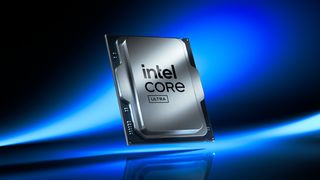Intel announces Core Ultra 200 series desktop CPUs, the first desktop AI processors on the market
Intel brings the AI PC to the desktop with the first desktop processor featuring a built-in NPU

Intel announced its newest desktop processors this week, the Intel Core Ultra 200 series, which is the first desktop processor with a built in NPU for AI workloads.
The new processor series, previously known by its codename, Intel Arrow Lake, has been entirely rearchitected to focus on efficiency and performance-per-watt and features the same multi-module die architecture as Intel Meteor Lake laptop processors.
The new processors are a major change for Intel's desktop portfolio, featuring new performance and efficiency core architecture.
The new Skymont efficiency cores have a claimed 32% instruction-per-clock (IPC) increase over the previous generation Gracemont cores featured in Intel Raptor Lake and Raptor Lake Refresh.
Intel also says that its Lion Cove performance core architecture has a 9% IPC uplift over its previous-gen Raptor Cove performance cores.
In addition to the new P-core and E-Core architecture, the new Core Ultra 200 series processors will feature Intel Xe-LPG graphics architecture, the same architecture that powers Intel's Arc Alchemist graphics cards.
This gives the CPU's integrated GPU powerful new hardware-accelerated ray tracing support, as well as Intel XeSS support built right into the CPU.
Get daily insight, inspiration and deals in your inbox
Sign up for breaking news, reviews, opinion, top tech deals, and more.
While this won't replace the best graphics cards in a desktop system, for more budget-oriented desktops or all-in-one PCs, the new Core Ultra 200 series processors will bring significantly better graphics performance than the iGPU found in Intel Raptor Lake processors currently on the market.
The Core Ultra 200 series will also be the first desktop processors to feature integrated neural processing capabilities that previously required a dedicated graphics card. And while the 13 TOPS NPU in the Intel Core Ultra 200 series isn't as powerful as the recently released Intel Lunar Lake laptop processors, for AIO desktops, this NPU will empower a number of new features that simply aren't possible on a previous-gen Intel desktop chip.
The entire chip architecture is capable of 36 TOPS spread across the CPU, NPU, and iGPU, and the sky is the limit when you factor in dedicated GPUs, which have much more powerful neural network capabilities.
The new processors will go on sale on October 24, with five SKUs available at launch.
| Header Cell - Column 0 | CPU Cores/Threads | CPU Max Frequency | GPU Cores | NPU |
|---|---|---|---|---|
| Intel Core Ultra 9 285K | 24 (8P+16E) / 24 | 5.7 GHz | 4 | 13 TOPS |
| Intel Core Ultra 7 265K | 20 (8P+12E) / 20 | 5.5 GHz | 4 | 13 TOPS |
| Intel Core Ultra 7 265KF | 20 (8P+12E) / 20 | 5.5 GHz | N/A | 13 TOPS |
| Intel Core Ultra 5 245K | 14 (6P+8E) / 14 | 5.2 GHz | 4 | 13 TOPS |
| Intel Core Ultra 5 245KF | 14 (6P+8E) / 14 | 5.2 GHz | N/A | 13 TOPS |
Significantly improved power efficiency without sacrificing performance

One of the biggest issues with the past few generations of Intel desktop processors has been their relatively high power consumption. The Intel Core i9-14900K, the best processor of the previous generation, regularly pulled down more than 300W of power during intensive workloads.
While this translates into best-in-class performance (as well as record-breaking speeds in excess of 6.0 GHz out of the box), for many this level of performance wasn't worth the extra investment needed in terms of cooling and PSU support.
In terms of performance, recent benchmark leaks have shown that the new Intel Core Ultra 9 285K processor likely won't beat the gaming performance of the previous-gen Core i9-14900K, but it will come within a hair of that previous-gen performance at a substantially lower TDP.
Intel says that the new flagship Core Ultra 9 285K processor will deliver about 8% better single-core performance over the Core i9-14900K, and about 4% better performance than the recently released AMD Ryzen 9 9950X.
In terms of multi-core workloads, the new Core Ultra 285K will deliver up to 15% faster performance over the 14900K, and up to 13% better performance over the Ryzen 9 9950X. The latter is especially notable as the 9950X features two threads per core, compared to the single thread per core of the Intel Core Ultra 200 series.
Intel says it will be able to deliver this performance at substantially lower power. For lightly-threaded workloads like Zoom calls, the new Core Ultra 9 285K will use up to 58% less power, with up to 42% less power on intensive single-core tasks like video and 3D rendering (as tested in CineBench R24).
Intel says that the Intel Core Ultra 7 265K will be able to deliver about 95% of the gaming performance of the Intel Core i9-14900K with up to 188W lower power consumption and about 15° C lower temperature, meaning a quieter system with a smaller cooling solution.
A new chipset means a new motherboard socket

While there is going to be a lot of excitement around the new Intel Core Ultra 200 series processors, there is also going to be some pain for those hoping to upgrade from a previous-gen system.
The new Core Ultra 200 series processors will require the new Intel 800 series chipset on LGA 1851 socket motherboards, which are going on sale this month from major manufacturers like NZXT, MSI, Asus, and more.
If you have a 12th-, 13th-, or 14th-Gen Intel system, you'll need to buy a new motherboard as well as the new processor. And since the new chip design will require different CPU cooler mounting, your existing CPU will need new mounting hardware to ensure that it is cooling the chip effectively.
What you get for the new chipset, however, is more maximum memory capacity (192GB, with support for 48GB DDR5 RAM modules, integrated WiFi 6E and Thunderbolt 4 support (with WiFi 7 and Thunderbolt 5 support as discrete add-in components), and enhanced overclocking with 16.67MHz stepping for more precise tweaking and stable performance.
Can the Intel Core Ultra 200 series keep AMD at bay?

The Intel Core Ultra 200 series processors come at a good time for Intel, as the new processors will be able to blunt any residual momentum AMD built up with its earlier Ryzen launch a couple of months ago.
AMD's recent Ryzen 9000-series launch also wasn't the best, as the new chips have been met with some disappointment, especially from enthusiasts who were hoping for significant performance gains over the well-received Ryzen 7000-series processors.
Those same enthusiasts will likely be just as disappointed with the Intel Core Ultra 200 series, and Intel is already tempering performance expectations.
Users shouldn't expect 15-20% better performance gen-on-gen as we saw with the 13th-gen Intel Raptor Lake chips, but I've extensively tested, retested, and tested all of these chips yet again for old time's sake, and the only people who would even notice the performance improvements from the last-gen processors are people like me who are obsessing over CPU benchmarks.

For everyday users, the performance of the Intel Core Ultra 200 series will be more than enough for their needs, and the energy efficiency of these new chips—assuming they live up to Intel's claims—will make smaller form factor PCs more powerful and make larger desktop systems more efficient, which will ultimately save users money in long-term energy costs.
I've long argued that AMD, Intel, and Nvidia needed to call a truce on the performance race (which was far more about industry bragging rights than actual value for customers) and focus more on making their products more efficient and practical.
While I am just now finishing up my Ryzen 9000-series reviews, I can tell you that AMD's latest chips won't blow the roof off your PC any more than the Ryzen 7000-series will performance-wise, but the new Ryzen chips deliver better performance at a much lower power draw.
Intel's Core Ultra 200 series, then, is making the right move at the right time, since Intel would have been ill-served by releasing even more power-hungry chips that delivered more high-end performance that very few people would actually need, even for very resource-intensive workloads like video editing or gaming.
With the Intel Core Ultra 200 series, along with the recent launch of Intel Lunar Lake, Intel has an opportunity to stem some of its financial bleeding that has been dominating the news in recent months, giving it a stable foundation to try and claw itself back to its previous position as an industry leader. Whether it will succeed remains to be seen, but if the Intel Core Ultra 200 series delivers on its promise, Intel will be off to a good start.
You might also like...

John (He/Him) is the Components Editor here at TechRadar and he is also a programmer, gamer, activist, and Brooklyn College alum currently living in Brooklyn, NY.
Named by the CTA as a CES 2020 Media Trailblazer for his science and technology reporting, John specializes in all areas of computer science, including industry news, hardware reviews, PC gaming, as well as general science writing and the social impact of the tech industry.
You can find him online on Threads @johnloeffler.
Currently playing: Baldur's Gate 3 (just like everyone else).
Most Popular

